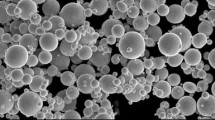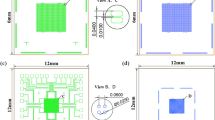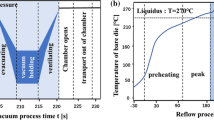Abstract
The interfacial reaction between Cu pad coated with Au/Ni and solder bump of flip chip package, using Sn97.5wt.%-Ag2.5wt%, was studied under thermal shock stress. All joints were subjected to thermal shock test with −65°C/+150°C temperature range. For the Sn-2.5Ag solder, a scallop-like (Cu,Ni)6Sn5 intermetallic compound was formed in the solder matrix after 20 cycles of thermal shock. (Cu,Ni)6Sn5 was detached from the interface as (Ni,Cu)3Sn4 grew underneath the (Cu,Ni)6Sn5 IMC(Intermetallic Compound), whereas the elements of Sn, Ni and Cu were moved by interdiffusion at the interface between solder alloy and Cu pad. The composition of the IMCs in the solder joints and elemental distribution across the joint interfaces were quantitatively measured with EPMA (electron probe micro analysis). Finally, it was found that the crack initiation point and its propagation path could be influenced by the thermal shock conditions, two underfills, and their properties.
Similar content being viewed by others
References
R. R. Tummala, Fundamentals of Microsystems Packaging, McGraw-Hill, New York, USA, (2001).
J. H. Lau and Y. H. Pao, Solder Joint Reliability of BGA, CSP, Flip Chip and Fine Pitch SMT Assemblies, McGraw-Hill, New York, USA, (1997).
H. J. Albrecht, Board level reliability of lead-free soldered interconnections, Proc. of International SMTA, (2000) 376–381.
C. Basaran and R. Chandaroy, Finite element simulation of the temperature cycling tests, IEEE Trans. Components Hybrids Manufacturing Technology, 20(4) (1997) 530–536.
M. Abtew and G. Selvaduray, Lead-free solders in microelectronics, Materials Science and Engineering R, 27(5–6) (2000) 95–141.
D. Suh, D. W. Kim, P. Liu, H. kim, J. A. Weninger, C. M. Kumar, A. Prasad, B. W. Grimsley and H. B. Tejada, Effects of Ag content on fracture resistance of Sn-Ag-Cu lead-free solders under high-strain rate conditions, Materials Science and Engineering A, 460–461 (2007) 595–603.
S. Y. Jang, J. Wolf, W. S. Kwon and K. W. Paik, UBM (Under Bump Metallization) study for Pbfree electroplating bumping: interface reaction and electromigration, Proc. Electronic Components and Technology Conference, San Diego, California, USA (2002) 1213–1220.
C. E. Ho, S. Y. Tsai and C. R. Kao, Reaction of solder with Ni/Au metallization for electronic packages during reflow soldering, IEEE Trans. on Advanced Packaging, 24(4) (2001) 493–498.
K. Zeng, V. Vuorinen and J. K. Kivilahti, Interfacial reactions between lead-free SnAgCu solder and Ni(P) surface finish on printed circuit boards,” IEEE Trans. on Electronics Packaging Manufacturing, 25(3) (2002) 162–167.
J. M. Kim, D. F. Farson and Y. E. Shin, Improvement of board level reliability for BGA solder joints using underfill, Materials Trans., 44(10) (2003) 2175–2179.
D. Suryanarayana, R. Hsaio, T. P. Gall and J. M. McCreary, Enhancement of flip-chip fatigue life by encapsulation, IEEE Trans. Components Hybrids Manufacturing Technology, 14(1) (1991) 218–223.
D. W. Wang and K. I. Papathomas, Encapsulant for fatigue life enhancement of controlled-collapse chip connection (C4), IEEE Trans. Components Hybrids Manufacturing Technology, 16(8) (1993) 863–867.
R. R. Tummala, E. J. Rymaszewski and A. G. Klopfenstein, Microelectronics Packaging Handbook, Second Ed. Chapman & Hall, New York, USA, (1997).
D. Z. Li, C. Q. Liu and P. P. Conway, Characteristics of intermetallics and micromechanical properties during thermal ageing of Sn-Ag-Cu flip-chip solder interconnects, Material Science and Engineering: A, 391(1–2) (2005) 95–103.
X. Deng, N. Chawla, K. K. Chawla and M. Koopman, Deformation behavior of (Cu,Ag)-Sn intermetallics by nanoindentation, Acta Materialia, 52(14) (2004) 4291–4303.
J. Y. Park, C. W. Yang, J. S. Ha, C. U. Kim, E. J. Kwon, S. B. Jung and C. S. Kang, Investigation of interfacial reaction between Sn-Ag eutectic solder and Au/Ni/Cu/Ti thin film metallization, Journal of Electronic Materials, 30(9) (2001) 1165–1170.
C. M. Liu, C. E. Ho, W. T. Chen and C. R. Kao, Reflow soldering and isothermal solid-state aging of Sn-Ag eutectic solder on Au/Ni surface finish, Journal of Electronic Materials, 30(9) (2001) 1152–1156.
J. Y. Tsai, Y. C. Hu, C. M. Tsai and C. R. Kao, A study on the reaction between Cu and Sn3.5Ag solder doped with small amounts of Ni, Journal of Electronic Materials, 32(11) (2003) 1203–1208.
K. N. Tu, A. M. Gusak and M. Li, Physics and materials challenges for lead-free solders, Journal of Applied Physics, 93(3) (2003) 1335–1353.
J. W. R. Teo, Thermal cycling aging effect on the reliability and morphological evolution of SnAgCu solder joints, IEEE Trans. On Electronics Packaging Manufacturing, 30(4) (2007) 279–284.
Author information
Authors and Affiliations
Corresponding author
Additional information
This paper was recommended for publication in revised form by Associate Editor Chongdu Cho
Kyoung Chun Yang received his B.E. and M.E. degrees in Mechanical Engineering from Chung-Ang University, Korea, in 2006 and 2008, respectively. His research interests include reliability in electronic packages, micro joints evaluation, advanced IC packaging/assembly technologies.
Seong Hyuk Lee received his Ph. D. degree in Mechanical Engineering from Chung-Ang University, Korea, in 1999. Dr. Lee is currently an Associate Professor at the School of Mechanical Engineering of Chung-Ang University in Seoul, Korea. His research interests are mainly in the micro/nanoscale energy conversion and transport, the computational physics associated with thin film optics, and thermal and fluid engineering.
Jong-Min Kim received his B.E. and M.E. degrees in Mechanical Engineering from Chung-Ang University, Korea, in 1997 and 1999, respectively. He then received his Ph.D. degree in Manufacturing Science from Osaka University, Japan, in 2002. Dr. Kim is currently an Associate Professor at the School of Mechanical Engineering at Chung-Ang University in Seoul, Korea. He has been mainly engaged in the fields of the interconnection & packaging technology in microelectronics and the intelligent assembly process in micro/nano systems.
Young Ki Choi received his B.E. and M.E. degrees in Mechanical Engineering from Seoul National University, Korea, in 1978 and 1980, respectively. He then received his Ph.D. degree in Manufacturing Science from Univ. of California, Berkeley, U.S.A., in 1986. Dr. Choi is currently a Professor at the School of Mechanical Engineering at Chung-Ang University in Seoul, Korea. He has been mainly engaged in the fields of the heat transfer in micro-nano systems and the numerical analysis of the heat transfer system.
Dave F. Farson received B.S. and M.S. degrees in Welding Engineering and Ph.D. degree in Electrical Engineering from The Ohio State University in 1987. He worked at Westinghouse R&D and Applied Research Laboratory at Penn State University before returning Ohio State University in 1995, where he is currently an Associate Professor in the Department of Integrated Systems Engineering. He is a past-president and Fellow of the Laser Institute of America and was co-editor of its Handbook of Laser Materials Processing. He is also active in the American Welding Society. He does research in laser materials processes and materials joining for a range of applications including biomedical and electronics device fabrication.
Young Eui Shin received his B.E.degree Mechanical Engineering from Chung-Ang University in Korea, and M.S and Ph.D degrees from Nihon Univ. and Osaka Univ. in 1985 and 1992 respectively. He worked as principal researcher in the Technical central lab of Daewoo Heavy industry from 1985 to 1988, and as a chief researcher in Technical Center of Samsung Electronics from 1992 to 1994. At present, he is a Professor at the School of Mechanical Engineering, Chung-Ang Univ., in Korea. He is also working as President, Korea Micro Joining Association. He has been mainly engaged in eco friendly materials application for micro system packaging and reliability evaluation for micro joints.
Rights and permissions
About this article
Cite this article
Yang, K.C., Lee, S.H., Kim, JM. et al. Characteristics of Sn-2.5Ag flip chip solder joints under thermal shock test conditions. J Mech Sci Technol 23, 435–441 (2009). https://doi.org/10.1007/s12206-008-1124-z
Received:
Revised:
Accepted:
Published:
Issue Date:
DOI: https://doi.org/10.1007/s12206-008-1124-z




